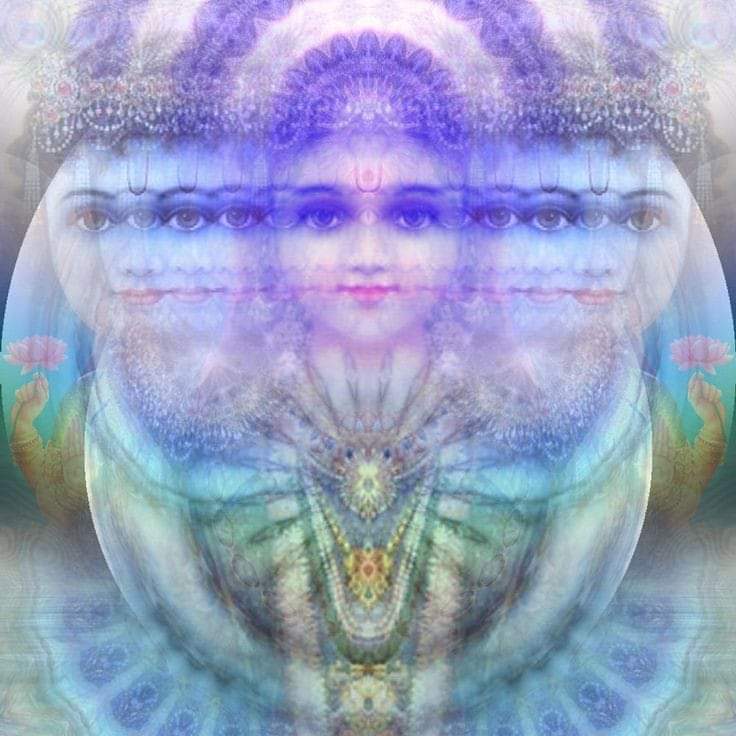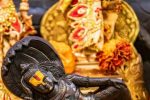NAME 84
Ātmavān आत्मवान्
He is established in Himself and every other being is supported by Him. The Brahman has no origin and everything else, both movables and immovables, originate from Him.
Chāndogya Upniṣad (VII.xxiv.1), “It rests on its own power – no, not even on that power (this means the Brahman does not depend on anything, not even His own power).” This is the basic principle of non-dualism or dvaita philosophy. Whatever that exist is only the Brahman. The duality arises only if two things are present. He is established in His own Greatness, He is the real Owner and Controller of the Souls of those who act virtuous, hence He is Atmavaan. Our sincerity of devotion, trust, and surrender unto Him will become the sole cause of our salvation. He is the kritajna pleased by our immensely small effort of sincere devotion, and He will cause our souls which He owns, and divert it towards actions that He Wills and then use that as the reason for conferring His blessings on us.
He is completely independent and does not need help from anyone. Sri Adi Sankara says ‘Sva Mahima Pratishthitatvaat Aatmavaan – He is Aatmavaan because he is firmly established in his own greatness’.
In Chandogya Upanishad it is said- ‘Sa Bhagavan Kasmin Pratishthitah iti sve Mahimni’ – Where is that God rooted? In his own Glory!
The real Owner and Controller of the souls of those who do these virtuous acts. One established in his own greatness i.e. requiring no other support than Himself. One who is the Self in all beings. In the Chandogya Upanishad when the disciple asks, “Where does the Lord, the Infinite, stand established?” the Shruti answers, “In its own glory established ever is the Self”-(Sve Mahimni Pratishthitah).
Chāndogyopaniṣad – Part Seven, Chapter 24
Yatranānyatpaśyati nānyat śr̥ṇoti nānyadvijānāti sa bhūmā’tha ya trānyatpaśya tyasyat śr̥ṇo tyanyadvijānāti tadalpaṃ yovai bhūmā tadamr̥ta matha yadalpaṃ tanmartyaṃ sa bhagavaḥ kasmin pratiṣṭhita iti sve mahimni yadi vāna mahimniti. (1)
:: छांदोग्योपनिषत् – सप्तमः प्रपाठकः, चतुर्विंशः खंडः ::
यत्रनान्यत्पश्यति नान्यत् शृणोति नान्यद्विजानाति स भूमाऽथ य त्रान्यत्पश्य त्यस्यत् शृणो त्यन्यद्विजानाति तदल्पं योवै भूमा तदमृत मथ यदल्पं तन्मर्त्यं स भगवः कस्मिन् प्रतिष्ठित इति स्वे महिम्नि यदि वान महिम्निति ॥ १ ॥
[Sanatkumāra said] Where one sees nothing else, hears nothing else, understands nothing else – that is the Infinite. Where one sees something else, hears something else, understands something else – that is the finite. The Infinite is immortal, the finite mortal. [Nārada inquired] Venerable Sir, in what does the Infinite find Its support? [Sanatkumāra responded] In Its own greatness – or not even in greatness.
Śrīmad Bhāgavata – Canto 10, Chapter 3
Evaṃ bhavānbuddhayanumeyalakṣaṇairgrāhyairguṇaiḥ sannapi tadguṇāgrahaḥ,
Anāvr̥tatvādbahirantaraṃ na te sarvasya sarvātmana ātmavastunaḥ. (17)
:: श्रीमद्भागवते दशमस्कन्धे तृतीयोऽध्यायः ::
एवं भवान्बुद्धयनुमेयलक्षणैर्ग्राह्यैर्गुणैः सन्नपि तद्गुणाग्रहः ।
अनावृतत्वाद्बहिरन्तरं न ते सर्वस्य सर्वात्मन आत्मवस्तुनः ॥ १७ ॥
With our senses we can perceive some things, but not everything. Consequently, He is beyond perception by the senses. Although in touch with the modes of material nature, He is unaffected by them. He is the prime factor in everything, the all-pervading, undivided Supersoul. For Him, therefore, there is no external or internal.
८४. ॐ आत्मवते नमः|
84. OM Ātmavate Namaḥ
Aatmavaan -One who is the Self in all beings. In the Chandogya Upanishad (7.24.1) when the disciple asks, “Where does the Lord, the Infinite, stand established?” the Sruti answers, “In Its own glory established ever is the Self”-(Sve Mahimni Pratishthitah).
Ātmanaḥ asya asti svapratiṣṭhātvena iti ātmavān / आत्मनः अस्य अस्ति स्वप्रतिष्ठात्वेन इति आत्मवान् As He is established in His own glory, He is Ātmavān i.e., requiring no other support than Himself.
INTERPRETATION GUIDED BY SANT VANI (WORDS OF SAINTS)
Ātmavān
The one who rests in His own glory.
Dhanavān is the one who has wealth. Balavan is the one who has bala, strength. Then what about the word, Atmavān? In the Gīta, Bhagavān tells Arjuna to be the one who is free from the pairs of opposites (such as pain and pleasure), to be free from the anxieties of acquiring and protecting, to be the one who is Atmavān, a master of oneself (2.45). In the verses, he teaches him, how. Here, the Atma is the Kārya- Karaṇa-sanghāta – the body-mind-sense-complex and not satcitānanda ātma which is already you.
A person whose thinking has a predominance of sattva guṇa, shows love for knowledge, a certain composure, clarity in thinking and goodness. One who is not taken for a ride by one’s own fancies, is called ātmavān. He/she focuses on what he/she knows and what can be done and hence frees himself/herself from the seeming limitations of the situation. Perhaps, there can be mistakes due to lack of knowledge, because a human being is of limited knowledge. But inspite of knowledge, one may not be an ātmavān; one may not be in control of oneself and is often driven by impulse, habit and mechanical thinking. In every action, there are three aspects involved: the thinker, the feeler and the doer. They are three aspect of the same person, not three entities. If they are not in alignment, then I experience myself in friction and not together as a person.
All of us have one or two areas in our life (health, family or finances) where we feel dictated by people or circumstances, where we feel helpless by force of habit. Rather than fight ourselves and berate ourselves, it is helpful to start implementing the change. In the context of trying to change a particular behavior, it is helpful to think what you want rather than what you don’t want to happen. This has a strong basis in biochemical changes that take place when one acts in a different way as repeated actions lead to neural pathways in the brain. Where the river flows over stones and pebbles that are there on the river bank, we see striations and patterns on the stones. Some people even pick them and keep them as mementos. It seems strange that on something as hard as a stone, the flowing water can make a difference. But it does! The patterns on these hard stones arise because of the force of the repeated flow of the waters. On the other hand, if we write on sand on the shore in the finest calligraphy, in a short time, the waters will wash away what we have written. Repetiton, abhyāsa helps when one is seeking to act in a desirable manner and give up an unhealthy habit. This is the situation of an individual. The attempt is to bring and discover harmony in the one who thinks, feels and does, the one who is together.
But, we cannot say that Bhagavān has ātmā and that He is together! If He is Īśvara there is no need to point out that He is together! Therefore, the meaning should be something else. Here it means that He is with Himself and not dependent on anything else. The jagat, world has its ātmā, its being, in the sat-cit-ānanda-ātmā. Jiva, the individual is ātmavān, because he is sat-cit-ānanda-
ātmā (From the standpoint of the absolute reality) Every sense organ is a sense organ because of ātmā. On what does Īśvara depend to be ātmavān? He is ātmavān, being established in His own svarūpa, own mahimā, glory. He exists in His own glory.
He who is the ‘Self’ in all beings. He who is centered in and established within the “Self” (Śaṅkara). He who ‘possesses’ the Ātma (of those who have turned to him) (Parāsara Battar)
I like Parāsara Battar‘s use of the word ‘possessor’ because that is what the Ākṛṣṇa of Viṣṇu feels like – ‘possessed’ – like the ‘possessiveness‘ of the Gopis who were in turn possessed by the ākṛṣṇa of Kṛṣṇa (irresistible attractiveness of Kṛṣṇa).
What this name also means is that it is the Universal Supreme Being who is the “Self” embedded inside each being and it is he alone who is the one self that has to be ‘realized’ – it is he who has ‘possessed’ each and every Ātma – We see this being expressed in the first two lines of the Puruṣasūkta which tell us:
सहस्रशीर्षा पुरुषः सहस्राक्षः सहस्रपात् ।
स भूमिं विश्वतो वृत्वात्यतिष्ठद्दशाङुलम् ॥१॥
Sahasra-Shiirssaa Purussah Sahasra-Akssah Sahasra-Paat |
Sa Bhuumim Vishvato Vrtva-Atya-Tisstthad-Dasha-Angulam ||1||
He thinks and sees through innumerable (thousand) heads/eyes, and walks on a thousand feet. He envelops the world and extends beyond like the stretched fingers of the palm (into eternal space).
So, what is this “Self” and what does it mean to be “possessed by the Self” and what does it mean to be ‘one with the Universal Self‘? Is even such a complete identification with the “Self” such that all difference vanish, possible at all?
In that dialogue between Sanatkumāra and Nārada, we come across the following:
यत्र नान्यत्पश्यति नान्यच्छृणोति नान्यद्विजानाति स भूमाथ यत्रान्यत्पश्यत्यन्यच्छृणोत्यन्यद्विजानाति तदल्पं यो वै भूमा तदमृतमथ यदल्पं तन्मर्त्य्ं स भगवः कस्मिन्प्रतिष्ठित इति स्वे महिम्नि यदि वा न महिम्नीति ॥ ७.२४.१ ॥
yatra nānyatpaśyati nānyacchṛṇoti nānyadvijānāti sa bhūmātha
yatrānyatpaśyatyanyacchṛṇotyanyadvijānāti tadalpaṃ yo vai bhūmā tadamṛtamatha yadalpaṃ tanmartyṃ sa bhagavaḥ kasminpratiṣṭhita iti sve mahimni yadi vā na mahimnīti ॥ 7.24.1 ॥
The infinite Supreme Being is the Bhūmā (self). In that Bhūmā, one sees nothing else (other than the Supreme Being), hears nothing else, and finds nothing else. The finite (on the other hand) is alpa (limited) this knowledge does not exist (the universality of the one, all-pervading consciousness). This is why the infinite is limitless, unchanging and immortal while that which is finite is limited, constantly changing, and mortal.
Nārada being Nārada then asks “Sir, then on what (substratum/foundation) does this Bhūmā rest?” Sanatkumāra says “That being rests in/on itself or perhaps on nothing, for it is independent of everything (but part of everything)”
What he means is that the Bhūmā is self-sufficient and when there is nothing other than that bhūmā that we can speak of or point to. Then how can we speak of supporting or not supporting? Know this – There is just one. The question of support arises only if there are two things. When the Self is one and indivisible the question of support does not arise.’
One day in Dakshineshwar Sri Ramakrishna Paramahamsa was standing on the banks of the river when he saw two boatmen fighting and one of the boatmen delivered a blow to the back of the other. Sri Ramakrishna cried out in pain. Hriday who rushed up to him saw an impression of the palm on Sri Ramakrishna’s back. Again, when someone walked on the grass outside the ashram, Sri Ramakrishna felt that someone had stepped on his chest such was his total identity with all being and all objects. When Sri Ramakrishna suffered from cancer and could not eat anything, his disciples asked him to go and request Mother Kali. He refused initially, holding that it was all her will, but they pleaded with him to ask her ‘for their sake’ and so he finally went and asked her. He came back and reported:
‘I told Mother that I could not eat because of the pain in my throat, and I asked her to allow me to eat something.’ ‘What did she say?’ they asked. Ramakrishna replied: ‘She showed me all of you, and then she said, “But you are eating through so many mouths.” I was ashamed and could not utter another word.’
This is the idea of the “Self” the one consciousness permeating and manifesting across several beings – from the level of the microcosm to the level of the macrocosm – the same “Self” – in one and all. There is a difference though – this manifestation of the ‘Self’ is not of the same degree and therefore not the ‘same’ everywhere and in every being – in some the consciousness of this oneness is sharper and in some even the last vestige of difference disappears – as seen in the example of Sri Ramakrishna – the difference is in the degree of manifestation. Like Vivekananda said, it is possible for everyone (to realize the self but so few come to the path, fewer still hold on and a minuscule few or more likely just one goes across…
kālena snāna-śaucābhyāṁ
Srimad Bhagavatam. 10.5.4
saṁskārais tapasejyayā
śudhyanti dānaiḥ santuṣṭyā
dravyāṇy ātmātma-vidyayā
Gradually, with the passage of time, bathing purifies the body; austerities purify old tendencies of the mind; charity purifies the wealth; contentment purifies the mind and self-realization purifies the soul.
https://os.me/courses/self-purification-a-15-days-discovery-of-the-self/
This name completes the 9th string of the Viṣṇu Sahasranāma consisting of 11 beads for a total of 84 beads till now.



